Cold case sex attacks: Scientists match DNA profiles to more than 80 rapists in Victoria
IN 1982 science hadn’t advanced enough to get useful evidence from DNA left at crime scenes. Now more than 80 rapists have been identified by scientists testing samples from unsolved cases in Victoria.
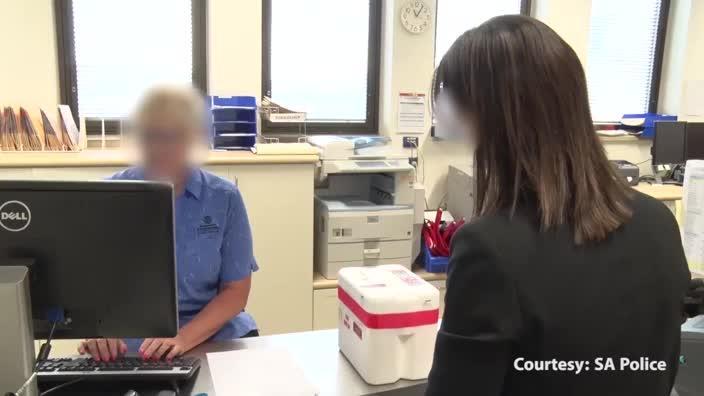
Law & Order
Don't miss out on the headlines from Law & Order. Followed categories will be added to My News.
THE grubby mark on the rape victim’s underwear wasn’t much use to the Victoria Police laboratory biologist in 1982.
Science hadn’t yet advanced enough for her to get any useful evidence from the stain, which might have been blood, semen, sweat, saliva or a mixture of all four.
DNA at the time was just something written about in a futuristic way in specialist forensic journals and the first use of DNA to solve a crime anywhere in the world was still five years away.
That case involved the mass testing in 1987 of more than 5000 men in the English town where two 15-year-old girls had been raped and murdered.
It led to the freeing of the man police had wrongly charged and the identification of Colin Pitchfork as the real killer.
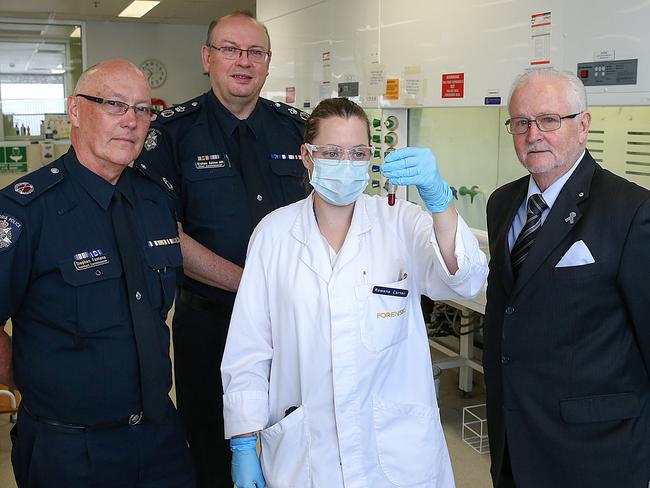
The first time DNA was used as evidence in a criminal case in Australia wasn’t until 1989.
Which makes it all the more remarkable that the then director of the Victoria Police forensic services centre, Dr Tony Raymond, had the foresight to say to colleagues in 1982 “we might be able to do something with that stain one day”.
And so the stain was cut out of the underwear and stored in the minus 70-degree freezer Dr Raymond bought specifically to store samples gathered from the scenes of unsolved crimes, mainly rapes.
Hundreds of samples from such diverse items as clothing, weapons and hairs were put in plastic bags and thrown into the spanking new freezer.
By the time the now Chief Commissioner Graham Ashton became aware of it in late 2009, when he was appointed as the lab’s director, there were 1936 samples from the scenes of 582 unsolved crimes in the freezer.
“When I first arrived I heard some of those working in the biology section talking about what they simply called ‘the freezer’, so I started asking questions about it,” Mr Ashton told the Herald Sun.
“That’s how I learned that way back in 1982 there was a decision made to start freezing and storing crime scene samples in the hope they would one day be valuable as identification evidence — and that all those samples were sitting in the freezer just waiting to be tested.”
The lab’s current assistant director of biology, John Scheffer, was a recent and junior employee at the time of the 1982 decision to start freezing samples from unsolved crime scenes.
“We recognised that if we didn’t do that then evidence that could potentially either implicate or exonerate an individual later on would be lost.
“The view was that we would eventually, one day, reap the benefits of that decision and that day has now come.”
Mr Ashton said scientists at the police lab were confident by 2011 that DNA technology had advanced sufficiently to enable them to successfully test the samples from the freezer to see if DNA could be obtained from them.
By that time he was back in the Victoria Police crime department as an assistant commissioner and had the clout to allocate significant resources to Mr Scheffer so every sample could be tested.
Mr Ashton followed that up in 2012 by creating a team of detectives, known as the cold case sexual crimes squad, to investigate the results of the DNA testing in the expectation charges would be able to be laid over the decades-old rapes.
Since then, more than 80 rapists have been identified directly as a result of getting DNA from the crime scene samples from hundreds of decades-old unsolved cases.
None of them were suspects for the sex attacks prior to the
samples being taken out of the freezer they had been stored in since
the early 1980s and 90s.
Mr Ashton recently organised a function so he could personally thank the Victoria Police forensic services centre staff who had the remarkable foresight to buy a freezer in 1982 to start storing samples from the scenes of unsolved crimes.
That decision was made seven years before the first use of DNA in a criminal case in Australia.
“Everyone from biology that is here today, you should take a bow for being part of that, for being a part of solving what in many cases are quite significant crimes, crimes of harm, crimes of violence in our community,” Mr Ashton said at the function.
“And for bringing closure to many victims that otherwise would not have achieved the justice they deserved.
“I thought it was very important to acknowledge the vision that people had in initially storing these samples.
“To me, it was really remarkable. DNA science was being talked about in scientific journals, but it wasn’t as yet a practical reality for law enforcement.
“I commend the wisdom of people in this room, and the vision, to think ‘well this is something that will come in the future’.
“You committed to that and started the process of storing what subsequently became important evidence.”
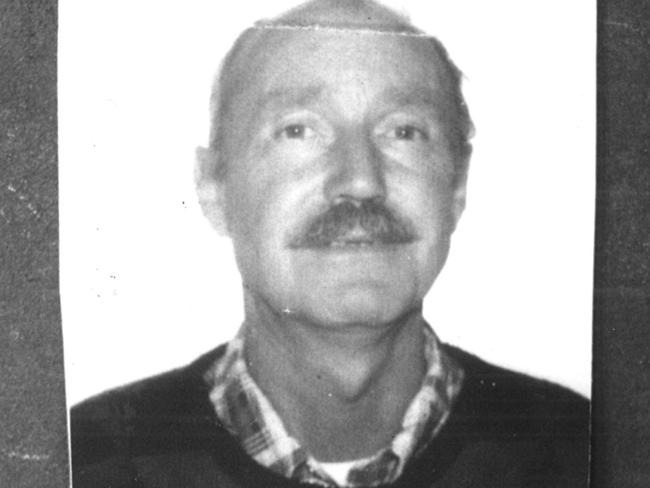
The mammoth task of testing every sample in the freezer resulted in 428 new DNA profiles being added to the national DNA database.
The results of the 1982 decision by Dr Raymond to store the samples — and Mr Ashton’s 2011 decision to begin testing them — have been spectacular.
Comparing all 428 DNA samples obtained from the freezer with the just over one million DNA samples on the national DNA database resulted in 113 cold hits relating to 290 sex offences.
A cold hit is when the DNA database randomly matches DNA from the scene of an unsolved crime with DNA from a person who until then wasn’t a suspect, or matches DNA from one crime scene with DNA from another — linking the crimes for the first time as being committed by the same serial offender.
Cold hits from DNA obtained from the freezer have so far resulted in 14 sex offenders being convicted and jailed over rapes on 19 victims; a further six cases are still before the courts; two prisoners in interstate jails will be extradited to Victoria and charged with decades old rapes as soon as they have served their sentences; cold case sexual crimes squad detectives are actively investigating another 28 cases; a further 115 cases will be probed as soon as resources become available; 13 rapists escaped being charged because they died in between the time of the rapes in the 1980s and 90s and the testing years later of the samples in the freezer identifying them as the offenders; three rapists got away with it because their victims decided they didn’t want to go through the trauma they feared resurrecting the cases would cause them and one rapist remains free because he now lives overseas in a country he can’t be extradited from.
— The 14 perverts already charged and convicted over 19 historic cold case rapes as a result of DNA from the freezer include:
ANTHONY JAMES PITT, it wasn’t until 2013 that semen samples found in the underwear of two teenagers raped in 1987 and 1988 were taken out of the freezer to have DNA extracted from them.
That DNA from the freezer produced a cold hit on the database with DNA Pitt was much earlier forced to provide after he was convicted in 1999 of abducting a 16-year-old girl and imprisoning her in a crude dungeon he made down a Ballarat mine shaft.

Pitt used the terrified teenager as a sex slave for 20 hours, repeatedly raping her on a filthy mattress. She was handcuffed, gagged and bound during various stages of her ordeal. Police mounted a huge search for the schoolgirl after her mother reported her missing. Sgt Peter Anderson squeezed through a small opening of the mine shaft.
He used a torch to find his way away along the old mining passage for 70 metres until the beam landed on two faces looking at him as he crawled towards them.
Sgt Anderson gave evidence that Pitt and his victim were lying side-by-side on a mattress when he discovered them and that Pitt “was busy pulling his pants up”.
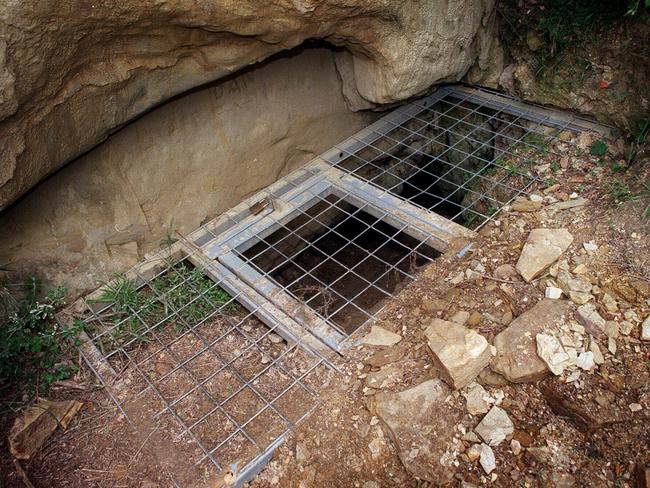
A search of the dungeon found the handcuffs Pitt had used on the schoolgirl while he was raping her. He was jailed for 17 years in 1999 for the Ballarat sex attack.
He was about to be released on parole in 2015 when police charged him over the 1987 and 1988 rapes the frozen samples from the freezer had implicated him in. Pitt, 59, was jailed in November last year for a maximum of 16 and half years over the 1980s rapes.
The victims, then aged 15 and 17, were attacked in Mildura and Frankston and dragged into bushes and raped.
COLIN SIMPSON HENDERSON, almost died after being extradited from the UK to face decades-old sex charges. He tried to avoid extradition, but lost his battle in London’s High Court. After travelling to Melbourne in May 2015 under police guard, Henderson collapsed at the Melbourne Custody Centre and was rushed to hospital in a critical condition.
He recovered and in July 2015, at the aged of 63, he was jailed for 15 years and ordered to serve a minimum of 11 after pleading guilty to raping three Melbourne women between 1981 and 1984. In each of the cases he had tricked his way into the homes of the victims after answering advertisements they had placed for a lodger.
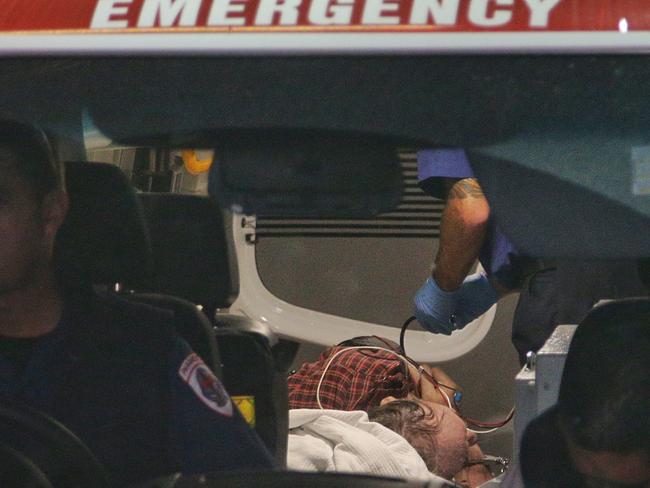
ANDREW SCHWAB, was jailed for six years and ordered to serve a minimum of three in 2016 for raping a toddler and a pregnant woman in two separate attacks in 1987. His 21-year-old victim was asleep in her Springvale home when Schwab broke in and covered her face with a doona.
She begged him not to harm her because she was four months pregnant. Schwab’s sick response was to pat her stomach before raping her twice. Just a month later, Schwab abducted a two-year-old boy from his bedroom and bashed and raped him before dumping the toddler outside the Springvale flat he was kidnapped from.
At the time Schwab was linked by DNA from the freezer in 2013 to the two 1987 sex attacks, he had been behind bars for five other rapes committed after the 1987 attacks he initially got away with.
STERLING BOWER, pleaded guilty in 2016 to raping a seven-year-old girl in the grounds of a Ringwood East kindergarten. Bower was 21 when lured her into bushland in 1989 before sexually abusing her and ordering her not to tell her parents.
The victim told the court 27 years after being raped that the attack had affected the way she treated her own children.
She cried as she said: “My children will never be able to walk to and from school alone because of what happened to me.”
Bower was jailed in 2016 for a maximum of six years and ordered to serve a minimum of three.
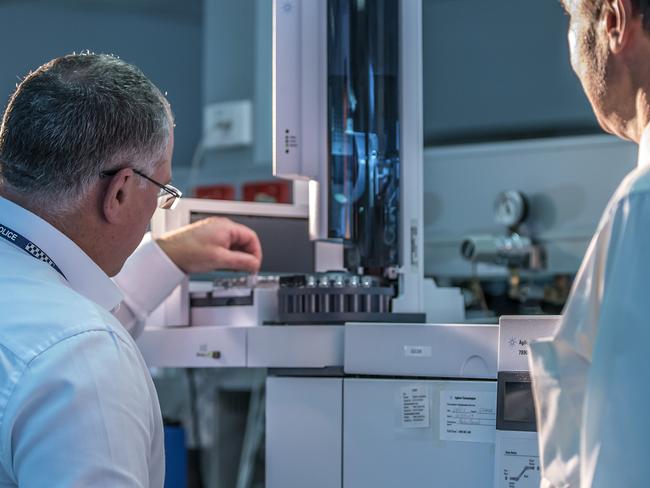
PIETER GEORGE HENDRIKS, jailed for 12 years in August 2014, more than three decades after he raped two women at knifepoint in Frankston within the space of two months in late 1983 and early 1984.
Forensic samples Hendriks left behind at the 1980s crime scenes were taken out of the freezer in 2011 and DNA obtained from them.
Those DNA samples were run through the national DNA database without a match being made. It wasn’t until Hendriks was arrested for drug offences in NSW in 2012 that his DNA was then added to the database, which randomly matched the DNA from the two rapes in Victoria in the 1980s to the DNA sample Hendriks was forced to provide after his 2012 arrest in NSW. He was a married father of two at the time of the rapes.
DAVID ROBERT VELLA, jailed for a maximum of six years in 2015 for the 1988 rape of a 15-year-old girl. Vella, then 23, grabbed her from behind after she left a Seaford sports centre. Holding a knife to her throat, Vella said: “Don’t move or scream or try to wave down a car or I’ll stab you in the stomach, cut your nipples off and slice your throat.”
Vella then forced the teenager into a vacant block between two factories and raped her. Immediately after the rape he told the victim he might “look you up in future”, a threat she told the judge in 2015 had “haunted” her for years afterwards.
The link between Vella and the victim was made in 2012 when forensic samples Vella had left at the 1988 rape scene were taken out of the freezer and successfully tested for DNA.
Vella continued to offend after initially getting away with the 1988 rape of the teenager, being jailed in 1996 and again in 2007 for other rapes.
Comparing DNA obtained from the freezer samples with DNA stored on the national DNA database from crime scenes around Australia resulted in detectives discovering 22 cases where the same unknown person committed multiple sex crimes.
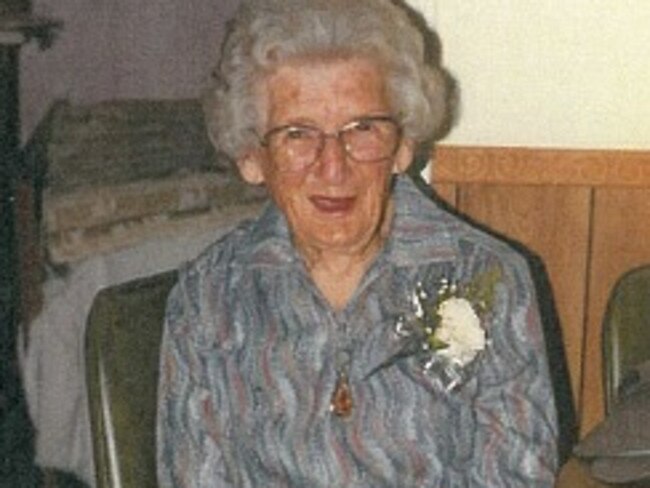
One of those cases involved grandmother Jessie Lauder, who died in 1993. She was attacked and raped in her Newport home in 1981 and again in 1983, when she was aged 82 and 83.
It wasn’t until decades later, when samples from both rapes were taken out of the freezer and DNA extracted from them, that detectives made the shock discovery that the same depraved pervert committed both offences.
Det-Sgt Nigel Freebairn hopes the $500,000 reward he announced last year will lead to the offender being caught more than three decades after he twice sexually attacked Mrs Lauder.
The DNA testing process from the freezer also led to the discovery that the same sex monster was responsible for five previously unsolved child abductions and rapes committed almost 30 years before the testing began.
Notorious Victorian paedophile Terry Shores would have been charged with those five attacks if he hadn’t died in 1993.
Cindy, who was 13 when Shores sexually attacked her in 1986, told the Herald Sun she was disappointed Shores died before he could be charged with raping her.
“But at least Shores can now be named and shamed for what he did,” she said.
Samples stored in the freezer were also responsible for identifying and helping convict one of Victoria’s most notorious and prolific serial rapists — not because of the mass testing from 2011 onwards, but because the then Det-Sgt Steve Fontana persuaded his bosses to let him take several of the frozen samples out of the freezer in 1987.

He did so because he was convinced George Gerald Kaufman was the man responsible for a shocking spate of rapes at knifepoint in the homes of women living alone in the North Caulfield and Armadale areas between 1982 and 1986, but didn’t have enough evidence to charge him.
Kaufman ended up being the first person convicted as a result of the freezer samples — that 1989 conviction over 19 rapes also meant he became the first person in Victoria to be convicted with the help of DNA evidence.
The Victoria Police forensic services centre didn’t have the expertise to do DNA testing at the time Det-Sgt Fontana told his bosses in 1987 that his two-year investigation had concluded Kaufman was the prime suspect to be the serial rapist.
Scientists at the lab had already matched a Nike shoeprint left at the scene of a 1986 burglary in Armadale St, Armadale, with a Nike shoe they later seized from Kaufman.
There was also a statement from Kaufman’s former wife, in which she said Kaufman — who spent six months in the Israeli army in the early 1980s — was obsessed with sex and knives and had once held a blade to the throat of their daughter.
“Sometimes he would come up from behind and just place the point on my ribs, saying ‘can you feel it’,” she told police in February 1987.
“On many occasions he would threaten me by saying he would cut my throat or gesture with the knife across the throat.”
What Det-Sgt Fontana, who is now in charge of the Victoria Police crime department as an assistant commissioner, told his then boss, Det-Inspector Dannye Moloney, was the shoeprint and other evidence wasn’t enough to link Kaufman to the rapes, saying this newfangled DNA thing was the way to go to secure a conviction.
Det-Insp Maloney used Det-Sgt Fontana’s comprehensive 1987 report on Kaufman to convince his bosses to spend the $20,000 needed to send a force scientist from Melbourne to the US to get samples from the rapes Kaufman was suspected of committing tested for DNA at a specialist laboratory.

The US boffins would also need Kaufman’s DNA so they could compare it with the DNA they expected to obtain from the samples taken from the Victoria Police freezer.
The problem was Det-Sgt Fontana didn’t have any forensic samples from Kaufman and at that stage the investigation was still an undercover one so he didn’t want to get a sample from Kaufman as doing so would alert him he was a target.
“So we got DNA from Kaufman’s daughter,” assistant commissioner Fontana said yesterday.
“The result that came back from the US was that the father of the child was the offender and that was enough for us to charge Kaufman with the rapes.
“There were only five or six of the rapes where we had a positive DNA match to Kaufman, but that gave us the foothold to go and do a really positive interview with him and he eventually admitted the offences and pleaded guilty to all of them.”
“That was a fantastic result, thanks to the freezer.”
Kaufman was convicted in 1989, at the age of 38, of 16 counts of aggravated rape, three counts of rape, 16 counts of burglary with intent to rape, 15 counts of robbery, intentionally causing injury and attempted aggravated rape.
He was jailed for a maximum of 21 years and ordered to serve a minimum of 18.
